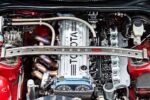Understanding the Cat C12 Marine Engine
A Brief History
The Cat C12 marine engine, developed by Caterpillar Inc., has been a staple in the marine industry since its introduction in the late 1990s. Caterpillar, a company renowned for its heavy machinery and diesel engines, designed the C12 to meet the growing demands of commercial and recreational marine applications. With a robust build and a reputation for reliability, the C12 quickly gained popularity among boat builders and marine operators alike.
This engine was engineered to deliver a balance of power and efficiency, making it suitable for various vessels, from fishing boats to luxury yachts. The C12 features a six-cylinder, in-line configuration, with a displacement of 12.5 liters, allowing it to produce impressive horsepower and torque. Its design incorporates advanced technologies aimed at enhancing performance while minimizing emissions, aligning with the industry’s shift towards more environmentally friendly solutions.
However, despite its strong reputation, the Cat C12 has not been without its issues. Over the years, users have reported a range of problems that can affect performance, reliability, and safety. Understanding these issues is crucial for anyone considering the C12 for their marine applications. As we delve deeper into the common problems associated with the Cat C12 marine engine, it becomes evident that while this engine has its strengths, potential buyers and current owners must be aware of the pitfalls that can arise.
Common Problems with the Cat C12 Marine Engine
The Cat C12 marine engine, while known for its durability and performance, has been reported to experience several issues that can hinder its operation. Understanding these problems is essential for maintenance and troubleshooting. Below are some of the most frequently encountered issues associated with the Cat C12.
1. Overheating Issues
One of the most common problems with the Cat C12 is overheating. This can be caused by several factors, including:
- Clogged cooling systems
- Faulty thermostats
- Insufficient coolant levels
- Malfunctioning water pumps
Overheating can lead to severe engine damage if not addressed promptly. Regular maintenance and monitoring of the cooling system are crucial to prevent this issue.
2. Fuel System Problems
Fuel system issues can significantly impact engine performance. Common problems include:
- Clogged fuel filters
- Contaminated fuel
- Faulty injectors
These issues can lead to poor fuel efficiency, reduced power output, and increased emissions. It is essential to regularly check and replace fuel filters and ensure the fuel quality is maintained.
3. Electrical System Failures
The electrical system in the Cat C12 is vital for its operation. Problems can arise from:
- Weak batteries
- Corroded connections
- Faulty wiring
Electrical failures can lead to starting issues and erratic engine behavior. Regular inspections of the electrical components can help prevent these problems.
4. Oil Leaks
Oil leaks are another prevalent issue with the Cat C12. Common sources of leaks include:
- Worn gaskets
- Damaged seals
- Poorly fitted components
Oil leaks can lead to low oil levels, which can cause severe engine damage if not addressed. Regular checks for oil leaks are necessary to maintain engine health.
5. Exhaust System Problems
Issues in the exhaust system can lead to performance problems and increased emissions. Common issues include:
- Clogged exhaust manifolds
- Damaged exhaust pipes
- Faulty turbochargers
These problems can affect engine efficiency and lead to overheating. Regular maintenance of the exhaust system is crucial for optimal performance.
Symptoms and Consequences
Understanding the symptoms of these problems can help in early detection and prevention of severe damage. Below is a table summarizing common symptoms and their potential consequences.
| Symptom | Possible Consequence |
|---|---|
| Engine overheating | Severe engine damage |
| Poor fuel efficiency | Increased operational costs |
| Starting issues | Inability to operate the vessel |
| Oil spots under the engine | Low oil levels leading to engine wear |
| Excessive smoke from exhaust | Increased emissions and potential engine failure |




0 Comments